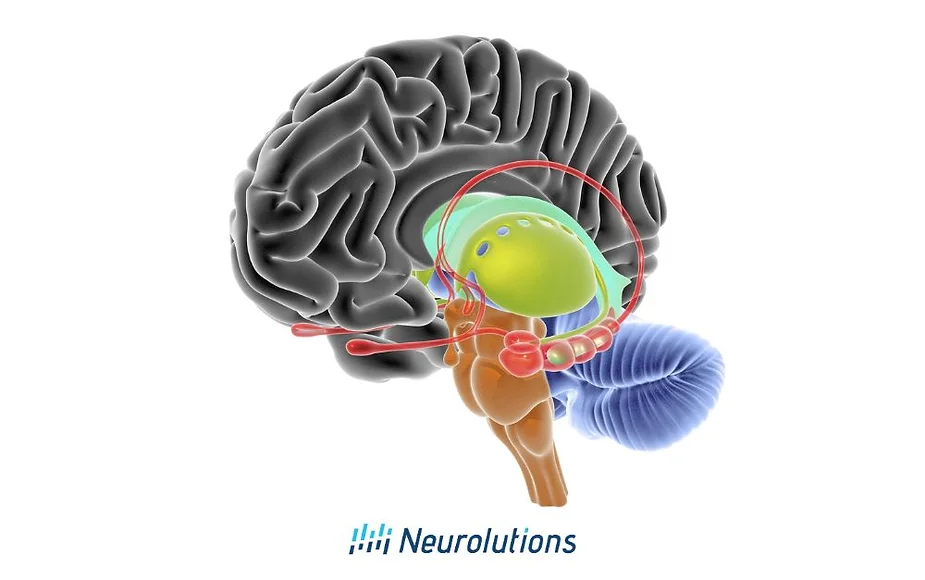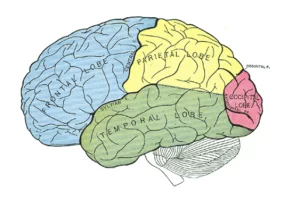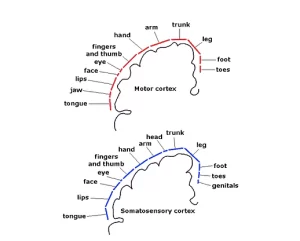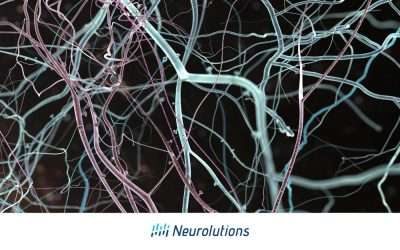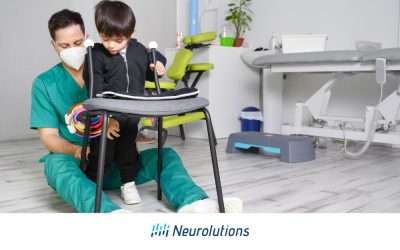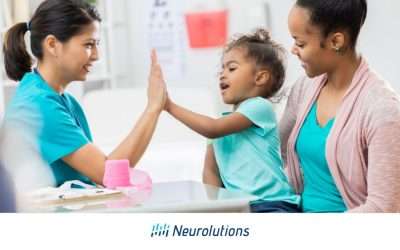In Latin, the word for “brain” is “cerebrum.” Cerebrum is the largest and most predominant part of the human brain, making up approximately 85% of the organ. This part of the brain is responsible for higher cognitive functions, conscious thought, memory, speech, the senses, and emotional responses.
When a stroke occurs and damages a specific area of the cerebrum, it can lead to various neurological deficits depending on the location and extent of the damage. This article discusses the areas of the cerebrum, common impairments caused by the stroke within the affected area, and an overview of rehabilitation and recovery.
Lobes of the Cerebrum
The cerebrum is divided into different lobes, and each lobe is responsible for specific functions. (1) The main lobes of the cerebrum that will be discussed in this article are:
- Frontal Lobe
- Parietal Lobe
- Temporal Lobe
- Occipital Lobe
Each lobe has specialized areas within it that perform different functions, and they work together to carry out the complex processes of perception, cognition, and motor control.
http://webspace.ship.edu/cgboer/genpsycerebrum.html
Frontal Lobe of the Cerebrum
The frontal lobe is responsible for higher cognitive functions, such as reasoning, problem-solving, and decision-making, personality and intelligence. It also contains the motor cortex, which controls voluntary movements and motor planning. The section of the motor cortex nearest to the top of the head controls the legs and feet, while the lowest portions of the motor cortex (closest to the temples) control the muscles of the mouth and face.
Parietal Lobe of the Cerebrum
The brain’s parietal lobe is a key part of contributing to your understanding of the world and processing sensory information. This includes touch, temperature, pain and spatial awareness. The parietal lobe includes an area called the somatosensory cortex. The somatosensory cortex is responsible for sensations of being touched across the body, perception, and object recognition.
http://webspace.ship.edu/cgboer/genpsycerebrum.html
Temporal Lobe of the Cerebrum
The temporal lobe is primarily associated with auditory processing, hearing, and language comprehension. It plays a role in memory formation, emotional regulation, and visual perception.
Occipital Lobe of the Cerebrum
The occipital lobe is located at the back of the head and is responsible for visual processing. It receives and interprets visual information from the eyes, allowing us to perceive and recognize visual stimuli.
What Happens When Stroke Affects the Cerebrum?
When a stroke occurs and damages a specific area of the cerebrum, it can lead to the loss of normal function in different parts of the body, including movement, sensation, speech, and language. The effects of a stroke vary depending on the location and extent of the brain damage.
The Effects Of A Right Hemisphere Stroke In The Cerebrum May Include (3):
- Left-sided weakness or paralysis
- Left neglect, which is a deficit in awareness after damage to the brain’s right side
- Visual problems with the left visual field of each eye
- Memory problems
- Spatial problems with depth perception or directions
- Inability to localize or recognize body parts
- Inability to understand maps and find objects
- Behavioral changes such as impulsivity, inappropriateness, and depression
The Effects Of A Left Hemisphere Stroke In The Cerebrum May Include (3):
- Right-sided weakness or paralysis and sensory impairment
- Problems with speech and understanding language (aphasia)
- Visual problems including the inability to see the right visual field of each eye
- Impaired ability to do math or to organize, reason, and analyze items
- Behavioral changes, such as depression, cautiousness, and hesitancy
- Impaired ability to read, write, and learn new information
- Memory problems
While the classical model you presented focuses on these specific brain regions, it is important to note that language processing involves a distributed network of brain regions, and our understanding of this network continues to evolve.(2)
Types of Strokes
There are two major strokes that can occur: ischemic (blockage) or hemorrhagic (bleed). Both types of strokes can happen at any part of the brain, different parts of the body. The type, severity, and location of the stroke will determine the side effects of the stroke. Regardless of the type and severity of a stroke, one side of the brain controls the opposite side of the body. The left hemisphere cerebrum affects the right side of the body, while the right hemisphere cerebrum affects the left side of the body.
Corpus Callosum
The corpus callosum is a thick bundle of nerve fibers that connects the right and left hemispheres of your brain (4). The purpose of the corpus callosum is to allow information to transmit from one side of the brain to the other, such as sensory, motor, and high-level cognitive neuro-signals. In addition, the corpus callosum plays a major role in movement control, cognitive function, and vision.
The diencephalon is inside the cerebrum above the brainstem. This part of the brain is responsible for sensory function, food intake control, and the body’s sleep cycle. The diencephalon is divided into three sections: the thalamus, hypothalamus, and epitheliums (1).
Rehabilitation and Recovery
It is indeed possible to live a happy and successful life after a stroke, despite the significant effects a stroke can have on an individual’s life. People can regain strength, improve their functional abilities, and achieve independence with the right medical care, rehabilitation, and support.
Stroke rehabilitation is a crucial aspect of recovery. It typically involves a multidisciplinary approach with professionals such as physical therapists, occupational therapists, speech and language therapists, and psychologists. The specific rehabilitation program is tailored to the individual’s needs and may include exercises, mobility training, speech and language therapy, cognitive rehabilitation, and emotional support.
The goal of stroke rehabilitation is to maximize recovery, restore function, and enhance quality of life. It can help individuals regain physical strength, improve coordination and balance, regain speech and language abilities, and regain independence in daily activities.
In addition to rehabilitation, adopting a healthy lifestyle is beneficial for recovery and overall well-being. This includes following a nutritious diet, engaging in regular physical activity (as recommended by healthcare professionals), managing other health conditions, and maintaining a supportive social network.
Emotional and psychological support is also crucial for stroke survivors and their families. Adjusting to the physical and emotional changes after a stroke can be challenging, and counseling or support groups can provide valuable guidance, coping strategies, and a platform for sharing experiences.
It’s important to remember that each individual’s journey and recovery process will be unique. With determination, support, and access to appropriate treatments and therapies, many stroke survivors are able to regain function, adapt to changes, and lead fulfilling lives.
Therapy can include:
- Physical Therapy
- Occupational Therapy
- Speech and Language Therapy
- Vision Restoration Therapy
- Hippotherapy
- Aqua Therapy
- Cognitive Therapy
- Animal-assisted Therapy
Each stroke recovery plan is tailored to the individual’s goals and abilities, ensuring that the rehabilitation process is client-centered and focused on maximizing independence and overall wellbeing.
Stroke recovery is a complex and ongoing process that can continue for months or even years after the initial stroke. Some individuals may experience significant improvements during the early weeks and months, (6) while others may have a slower and more gradual recovery.
The brain has capacity for neuroplasticity, which means it can reorganize and form new neural connections to compensate for the areas damaged by the stroke. With time, consistent therapy, and appropriate interventions, individuals can continue to make progress in their recovery beyond the early stages of stroke rehabilitation. For innovative recovery tools that utilize the concept of building new neural connections, learn more about the IpsiHand.
It is crucial to have realistic expectations but also continue to seek therapeutic opportunities to challenge the brain. The focus of stroke rehabilitation is to help individuals achieve the highest level of functional independence and quality of life possible, regardless of the timeline or specific percentages of recovery. The rehabilitation process is often individualized, tailored to the needs and goals of each person, and should continue as long as progress is being made. If progress seems to stall, continue to seek expert opinion to use techniques that could be a catalyst for brain and functional recovery.
|| Learn More About Stroke Recovery
Cerebrum and Stroke
The cerebrum indeed plays a vital role in our emotions, movement, sensory perception, cognition, and overall understanding of the world.
When a stroke damages a part of the cerebrum, it can indeed affect different aspects of our being and lead to behavioral concerns. However, with appropriate treatment, support, and rehabilitation, it is possible to live a long and successful life after a stroke.
Being actively involved in your stroke recovery plan and working closely with your healthcare team is crucial. They can provide guidance on the best treatment options available based on the location and effects of your stroke. Rehabilitation, therapy, medication, and lifestyle changes may all be part of your recovery plan, tailored to your specific needs.
Making lifestyle changes to reduce the risk of future strokes is also important. Following the preventive measures I mentioned earlier, such as managing blood pressure, maintaining a healthy diet, exercising regularly, quitting smoking, and managing other health conditions, can significantly lower the risk of stroke recurrence.
It is essential to have open and regular communication with your healthcare professionals, follow their recommendations, and actively participate in your recovery journey. Understanding your stroke, its effects, and available treatment options will empower you to make informed decisions and work towards a successful recovery.
Remember, every stroke and every individual’s recovery journey is unique. With determination, support, and the right treatment, many stroke survivors are able to regain function, adapt to changes, and lead fulfilling lives.
References:
- https://www.sciencedirect.com/topics/neuroscience/cerebrum
- http://webspace.ship.edu/cgboer/genpsycerebrum.html
- https://www.hopkinsmedicine.org/health/conditions-and-diseases/stroke/effects-of-stroke
- https://www.ncbi.nlm.nih.gov/books/NBK448209/
- https://www.stroke.org/-/media/Stroke-Files/Lets-Talk-About-Stroke/Life-After-Stroke/LTAS-Rehab-2019.pdf
- https://www.ncbi.nlm.nih.gov/pmc/articles/PMC4415968/
- https://www.stroke.org/-/media/Stroke-Files/life-after-stroke/Life-After-Stroke-Guide_7819.pdf#page=23
- Hendricks HT, van Limbeek J, Geurts AC, Zwarts MJ. (2002). Motor recovery after stroke: a systematic review of the literature. Arch Phys Med Rehabil 83:1629–1637.

